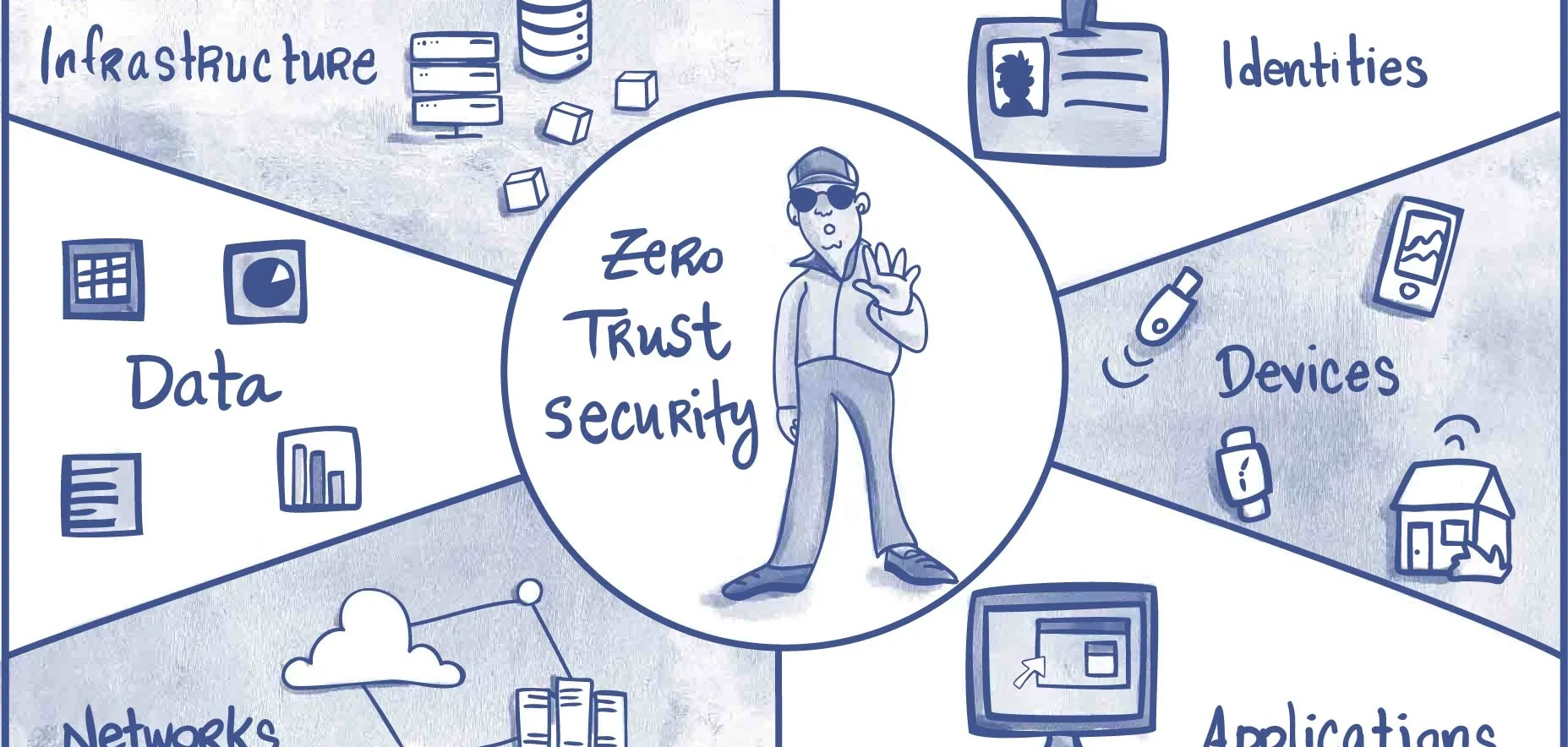Your cart is currently empty!

Implementing Zero-Trust Architecture: A Comprehensive Guide-2025
As I explore cybersecurity, I often ask: Can zero-trust architecture change an organization’s security? With more cyber threats, using a zero-trust security model is now urgent. Zero trust, architecture, and security are key, not just ideas. This guide will cover the basics of zero-trust architecture and how to implement it. A futuristic digital landscape depicting a…
As I explore cybersecurity, I often ask: Can zero-trust architecture change an organization’s security? With more cyber threats, using a zero-trust security model is now urgent. Zero trust, architecture, and security are key, not just ideas. This guide will cover the basics of zero-trust architecture and how to implement it.

A futuristic digital landscape depicting a zero-trust architecture framework, featuring interconnected networks and cloud elements secured by multiple layers of protection, diverse technology icons representing identity verification and access controls, vibrant colors blending cyberpunk themes with a sense of security, intricate patterns symbolizing data flow and encryption, all set against a sleek, modern backdrop. Brand: techtoknow.io.
Adopting zero trust offers many benefits, like lowering data breach risks and better incident response. But, what’s needed to set up a zero-trust architecture, and how to face its challenges? This detailed guide will outline zero trust security’s core principles and the essential parts of zero trust networks.
Table of Contents
Key Takeaways
- Understanding the basics of zero-trust architecture is key for its use
- Zero-trust security models can cut down data breach risks and enhance incident response
- Setting up zero-trust architecture needs a deep grasp of an organization’s security needs
- Zero-trust networks depend on elements like network segmentation and access control
- A zero-trust approach can boost an organization’s overall cybersecurity stance
Understanding the Fundamentals of Zero-Trust Architecture
Exploring zero-trust architecture, I see it’s key to grasp its core principles. The zero trust model trusts no user or device, inside or outside the network. This has led to the creation of zero trust networks, adding an extra security layer.
For a zero trust network to succeed, understanding least privilege and micro-segmentation is vital. It means giving users and devices only the access they need. The network is then split into smaller, safer zones. This way, organizations can lower the risk of a breach spreading, a big part of zero trust networks.
Some key parts of zero trust networks are:
- Identity and access management
- Network segmentation
- Encryption
These elements work together to build a strong security stance, which is essential for the zero-trust model. Adopting zero trust helps organizations strengthen their security, cut down on risks, and meet compliance
In summary, knowing the basics of zero-trust architecture is vital for better security. By using a zero trust model, companies can lessen breach risks and enhance their security. Zero trust is gaining traction across many industries, showing its wide benefits.
Related Read: Zero Trust Adoption Framework Overview
Assessing Your Organization’s Security Needs
To see if a zero trust architecture is right for you, start with a security check. Look for weak spots, check your current security, and figure out how much risk you can handle. Zero trust helps by making sure only the right people and devices get to important stuff.
Think about these things when checking your security:
- Network setup and how it’s divided
- How devices and users log in
- How data is kept safe and who can see it
- How you handle threats and find problems
Doing a good security check will show you where zero trust can help. It makes your security better and keeps your data safe from hackers. It also helps you follow the rules set by law.
“Visual representation of a zero-trust architecture framework, showcasing a network environment with multiple layers of security, user authentication checkpoints, segmented access zones, and cloud integration. Include visual elements like firewalls, encrypted data flows, and device management. The design should be modern and sleek, conveying a sense of advanced technology and security measures. Incorporate the brand name ‘techtoknow.io’ subtly in the design.”
For instance, zero trust works well with cloud systems. It makes sure only the right people and devices can see your important data. This stops hackers and keeps your data safe.
In short, checking your security is key to knowing if zero trust is for you. A good security check and using zero trust can make your security stronger. This lowers the chance of cyber attacks.
| Security Assessment Factors | Zero-Trust Architecture Example |
|---|---|
| Network infrastructure and segmentation | Verify user and device identity before granting access to sensitive resources |
| Device and user authentication protocols | Implement multi-factor authentication to prevent unauthorized access |
| Data encryption and access controls | Encrypt sensitive data and implement role-based access controls |
Building Your Zero-Trust Implementation Strategy
Creating a zero-trust strategy is a big deal. Companies that have done it well show better security and less risk. First, we need to know what resources we have, like data, devices, and users. This helps us decide who gets to access what.
Network segmentation is key for zero trust. It means breaking the network into smaller parts, each with its own security rules. This makes it harder for bad actors to move around and helps keep things safe. Access control framework development is also important. It makes sure only the right people and devices can get to important stuff.
Choosing the right authentication protocols is another big step. This means picking methods that make sure only the right people can get in. Things like multi-factor authentication and single sign-on are good choices. They help keep sensitive stuff safe from unauthorized access.

A futuristic digital landscape depicting a zero-trust architecture, featuring a network of interconnected nodes with secure access points, layered firewalls, and data encryption shields. Include visual representations of user authentication, multi-factor security, and continuous monitoring. Integrate elements of cloud computing and cybersecurity without any text or characters. Brand name: techtoknow.io.
- Identify and classify resources
- Develop a network segmentation plan
- Create an access control framework
- Select authentication protocols
By taking these steps, companies can build a strong zero-trust plan. This plan will help protect their security better.
| Zero Trust Component | Description |
|---|---|
| Resource Identification | Identify and classify resources, including data, devices, and users |
| Network Segmentation | Divide the network into smaller, isolated segments with access controls and security measures |
| Access Control Framework | Develop a framework to ensure only authorized users and devices have access to sensitive resources |
| Authentication Protocol Selection | Choose the right protocols for secure authentication and authorization |
Technical Components of Zero-Trust Networks
Exploring Zero-Trust Networks, I see that network architecture is key to security. Zero trust statisticsshow a well-designed network can lower data breach risks. A zero trust report by a top cybersecurity firm stresses the need for a zero-trust approach.
Important technical parts of Zero-Trust Networks include:
- Identity and access management
- Encryption
- Monitoring and analytics
These elements form a strong security system. They help detect and handle threats quickly.
To set up a Zero-Trust Network, knowing the technical parts is vital. Keeping up with zero trust statistics and zero trust report helps organizations protect their data.
Overcoming Common Implementation Challenges
Exploring zero trust architecture, I found it’s not easy to start. One big issue is dealing with common challenges that can slow down a zero trust project. Getting employees on board is key to a smooth transition.
Challenges like legacy system integration can be tough for many. To tackle this, you need a detailed plan that fits your organization’s needs. This might mean setting aside budget and resources for the zero trust setup.
- Know your organization’s security needs and goals well
- Make a solid training plan for your team
- Make sure you have enough budget and resources for zero trust
By understanding these challenges and following these steps, you can make a successful switch to zero trust. Remember, zero trust is an ongoing effort that needs constant checking and improvement to stay effective.
Conclusion: Securing Your Future with Zero Trust
Zero-trust architecture is a big change in cybersecurity. It moves away from old ways of protecting data to a new method. This method checks and changes as threats grow. It helps keep data safe and reduces damage from breaches.
Starting on the zero-trust path might seem hard. But, the benefits are worth it. Companies can slowly add zero-trust to their systems. This makes everyone in the company think about security.
I urge you to start using zero-trust architecture. Use the tips and advice in this guide to make your security strong. This will help keep your company safe now and in the future. Let’s work together to make the internet safer for everyone.
FAQs
What is Zero-Trust Architecture?
Zero-Trust Architecture is a security model that checks users, devices, and apps before they access resources. It moves away from old security methods to a more detailed approach. Here, trust is never given and must always be checked.
What are the core principles of Zero-Trust Security?
Zero-Trust Security’s main principles are the least privilege, micro-segmentation, constant monitoring, and zero trust for all users and devices. This is true, no matter where they are or what network they’re on.
What are the key components of Zero Trust Networks?
Zero Trust Networks rely on identity and access management, network segmentation, encryption, and advanced threat detection. These help keep the network safe and secure.
What are the benefits of adopting Zero-Trust Architecture?
ero-Trust Architecture boosts your security, lowers risks, and meets compliance standards. It also gives you better control and visibility over what users and devices do.
How can I assess my organization’s readiness for Zero-Trust Architecture?
To check if your organization is ready for Zero-Trust, do a detailed security review. Look for weaknesses, check your current security measures, and figure out how much risk you can handle.
What are the key steps in building a Zero-Trust implementation strategy?
To create a Zero-Trust plan, first identify and classify your resources. Then, plan your network segmentation, develop an access control framework, and choose your authentication protocols.
What are the technical components of a Zero-Trust Network?
A Zero-Trust Network includes network design, identity and access management, encryption, and monitoring and analytics tools, which are key to its security.
What are some common challenges in implementing Zero-Trust Architecture?
Challenges in Zero-Trust include training employees, integrating with old systems, and managing budgets and resources. These hurdles can slow down your implementation.


